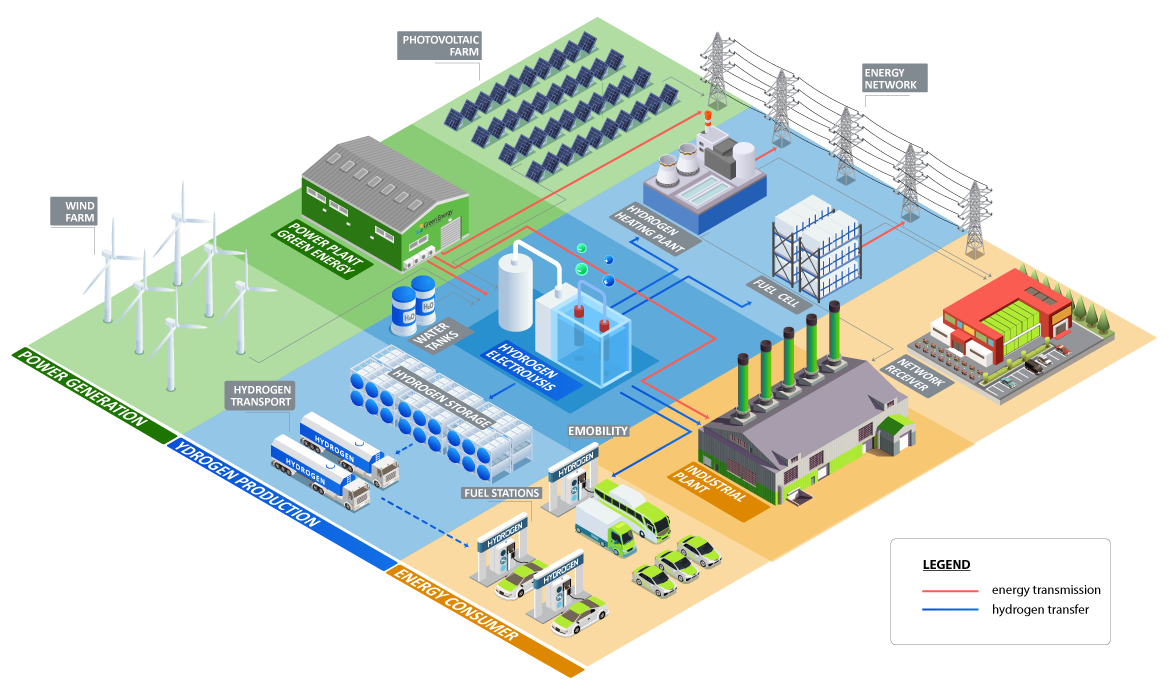
ENERGY AND HYDROGEN HUB
Hydrogen is the simplest element in the periodic table of elements. It has the symbol H and an atomic number of 1, meaning it has only one proton in its atomic nucleus. It is also the lightest of all chemical elements. Hydrogen exists in a gaseous state at standard temperature and pressure (0°C and 1 atm). It is also the only element that occurs as a gas under normal atmospheric conditions. It is the lightest known element and has a very low density. It is about 14 times lighter than air. Hydrogen is very chemically reactive. It forms numerous chemical compounds, including water (H2O) in reaction with oxygen and organic compounds in reactions with other elements and compounds. Hydrogen can be successfully used in various sectors because it is a high-energy fuel (33 kWh/kg), making it a significant competitor to battery technologies.
In a direct comparison of hydrogen with batteries, where their energy density ranges from 250-260 Wh/kg, hydrogen, as the leader, has about 125 times greater energy density per 1 kg. Introducing hydrogen as a technology will allow for a smooth reduction of the economy’s emissions. Countries on all continents are continuously striving to find new alternatives for the development of climate-neutral technologies. The European Union has set a goal to achieve total climate neutrality by 2050; capturing and storing the same amount of greenhouse gas emissions that will be released into the atmosphere. This is a very realistic goal, considering how quickly technology is developing today, and if they are effective and produce the desired results, they are implemented immediately.
Hydrogen can be used in transportation, industry, and energy. Hydrogen is an energy carrier, capable of storing large amounts of it (33 kWh/kg). In places where battery technologies fail, such as covering long-term electricity shortages in the transmission system, hydrogen is an ideal alternative. Stored hydrogen, whether in storage tanks or gas systems, can then be converted back into electricity in combination with oxygen using fuel cell technology.
Hydrogen is becoming a very optimistic solution to the problems of the new “New Green Deal” climate policy and the growing aspirations to use only green energy and eliminate fossil fuels (entirely). Hydrogen can play a significant role in the new energy policy as a green and sustainable energy source, contributing to the reduction of greenhouse gas emissions, diversification of energy sources, and the development of modern technologies.
Below are some aspects in which hydrogen can be included in the new energy policy:
- Hydrogen fuel: Hydrogen can be used as fuel in fuel cells, which generate electricity through the electrochemical oxidation of hydrogen. Fuel cells are efficient, effective, and produce only clean water as a byproduct, making them environmentally friendly. Implementing hydrogen vehicles and infrastructure for the production and distribution of hydrogen can help reduce CO2 emissions in transportation.
- Energy storage: Hydrogen can serve as an energy carrier, allowing the storage of excess electricity from renewable sources such as solar and wind. Hydrogen can be produced during periods of excess energy and later used to generate electricity during shortages, helping to sustainably use renewable energy sources.
- Decarbonization of industry: Hydrogen can be used in industrial processes such as steel and ammonia production to replace conventional fossil fuel-based hydrogen sources. This “green” hydrogen can help reduce CO2 emissions from the industrial sector.
- Public transport: Hydrogen can be used in public transport means such as buses, trains, and hydrogen taxis. Promoting the development and implementation of these vehicles can contribute to reducing emissions in the transport sector.
- Research and development: Investments in hydrogen-related research and development are crucial for developing new technologies for the production, storage, and use of hydrogen. The new energy policy can support research projects and innovations related to hydrogen.
Low-emission hydrogen will be useful in a low-carbon world as an energy carrier and when end-use applications are too difficult or expensive to electrify. Therefore, hydrogen plays a key role in modeled scenarios of a zero-emission future.
Countries are planning paths to reduce net greenhouse gas emissions based on clean hydrogen, leading to growing interest in investments worldwide. Potential producers see an economic opportunity in exporting clean hydrogen. Potential consumers recognize the benefits of decarbonization and energy security. However, global interest is just beginning to turn into investments.
Regional innovation clusters, which typically include universities, laboratories, research parks, incubators, and manufacturing centers, have long supported economic growth, job creation, and competitiveness. Concentrating innovative activities geographically, even in a joint center or research park, can facilitate collaboration and information exchange between scientists, engineers, and companies. With appropriate incentives, it is possible to coordinate their research efforts so that they share expensive equipment and provide complementary resources.

A hydrogen hub is the main user of green hydrogen, which will use renewable electricity from the grid to produce appropriate supplies of green hydrogen via an electrolyzer and store this hydrogen in high-pressure tanks. The storage can have several functions:
- the electrolyzer can be sized based on average demand rather than peak demand,
- storage potentially separates production and use, allowing the electrolyzer to use the cheapest renewable electricity when available, · stored hydrogen can be used as a backup in case of a power outage.
The electrolyzer, storage, and basic application will need to be optimized for the most economically beneficial use
In addition to meeting the primary application of the main user, the hydrogen hub can supply hydrogen to nearby smaller users and profit from it.
The hydrogen hub is the entirety of the infrastructure needed for hydrogen production. It includes:
- hydrogen production facility – electrolyzers,
- logistics infrastructure distribution infrastructure.
The size and type of installations included in the hubs depend on the source of hydrogen.


































